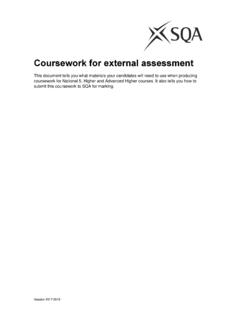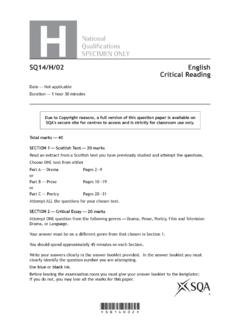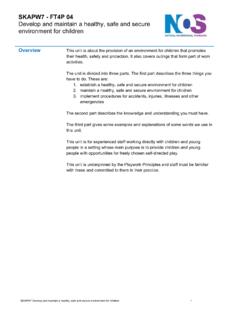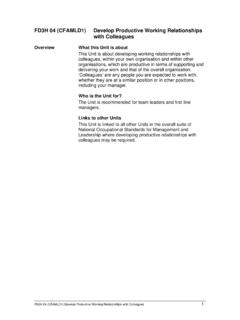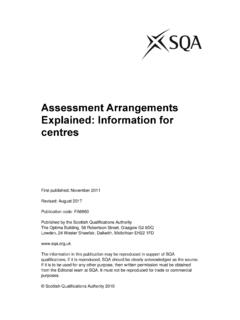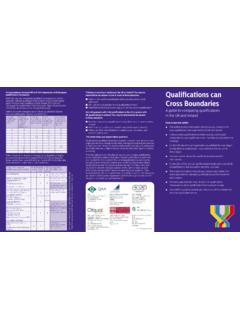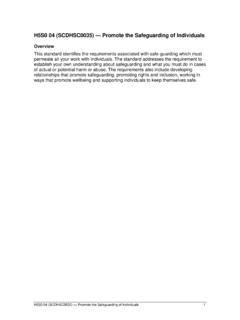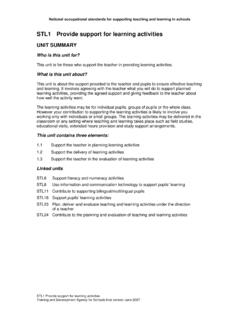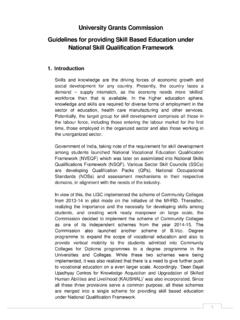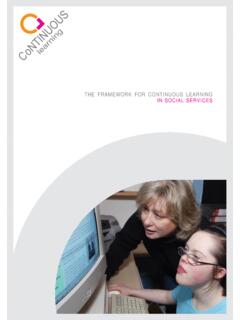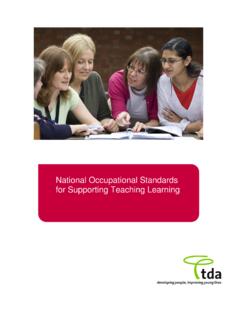Transcription of National Occupational Standards - SQA
1 National Occupational Standards for learning and DevelopmentMarch 2010 NationalOccupationalStandardsS4 | Performance Criteria with the Knowledge and Understanding2 National Occupational Standards for learning and Development1. Introduction 32. Who are the National Occupational Standards for? 33. What do the National Occupational Standards for learning and Development cover? 44. Structure and coverage of the National Occupational Standards for learning and Development 55. What s new in the National Occupational Standards for learning and Development? 66. What other NOS could be useful to learning and development practitioners? 77. What do the new NOS mean for qualifications? 78. The National Occupational Standards for learning and Development 8 Key area A: Research learning and development needs 9 Standard 1 Identify collective lear ning and development needs 9 Standard 2 Identify individuals learning and development needs 11 Key area B: Plan and develop learning and development opportunities 13 Standard 3 Plan and prepare learning and development programmes 13 Standard 4 Plan and prepare specific learning and development opportunities 16 Standard 5 Develop and prepare resources for learning and development 19 Key area C: Facilitate learner achievement 21 Standard 6 Manage learning and development in groups 21 Standard 7 Facilitate individual learning and development 24 Standard 8 Engage and support learners in the learning and development process 26 Standard 9 Assess learner achievement 29 Key area D.
2 Maintain and improve quality Standards 32 Standard 10 Reflect on, develop and maintain own skills and practice in learning and development 32 Standard 11 Internally monitor and maintain the quality of assessment 35 Standard 12 Externally monitor and maintain the quality of assessment 38 Standard 13 Evaluate and improve learning and development provision 40 Contents3 National Occupational Standards for learning and Development 1. IntroductionNational Occupational Standards (NOS) for learning and Development were first approved in 2001. Since their introduction, they have been extensively used within the learning and development community by a range of practitioners engaged in industrial and work based training, qualification delivery and consultancy. Many individual NOS have been adopted by other sectors, such as justice, social care and land-based industries, to cover their learning and development roles. Individual NOS from the suite have been very widely used as part of the assessor and verifier qualifications which are a requirement for N/SVQ delivery.
3 During 2009, Lifelong learning UK carried out an extensive programme of research and consultation with the learning and development community and with other Sector Skills Councils and awarding organisations. As a result we have now revised and updated these NOS to make them more streamlined and reflective of current good practice. 2. Who are the National Occupational Standards for?The NOS are designed for learning and development practitioners who are involved in developing and assessing the skills, knowledge and competence of learners primarily in the workplace or in work-related programmes of learning . They apply therefore to the following types of job roles in the lifelong learning sector for which learning and development is the main purpose: in-house trainers and training managers external trainers, managers and consultants assessors addition, individual NOS will be valuable to staff in all sectors who have a learning and development function as part of their job role; for example: workplace managers and supervisors experienced staff with responsibility for developing colleagues with less experience, skills and knowledge assessors Occupational Standards for learning and DevelopmentIntroduction4 3.
4 What do the National Occupational Standards for learning and Development cover?There are 13 NOS for learning and Development, which are based on a familiar structure known as the training cycle or learning cycle . This is presented in the following phases or key areas . A. Research learning and development needs. B. Plan and develop learning and development opportunities. C. Facilitate learner achievement. D. Maintain and improve quality diagram shows how the NOS for learning and Development fit into this structure. It is important to note that the NOS for learning and Development only cover what is exclusive to learning and development. Other approved NOS for example covering management and leadership or personnel may be necessary to provide full coverage for some job Occupational Standards for learning and DevelopmentIntroduction5 4. Structure and coverage of the National Occupational Standards for learning and DevelopmentWith a focus on training and development, the structure of the learning and Development suite of NOS follows the typical training area A: Research learning and development needs1 Identify collective learning and development needs 2 Identify individuals learning and development needsKey area D: Maintain and improve quality standards10 Reflect on, develop and maintain own skills and practice in learning and development11 Internally monitor and maintain the quality of assessment12 Externally monitor and maintain the quality of assessment13 Evaluate and improve learning and development provisionKey area B.
5 Plan and develop learning and development opportunities3 Plan and prepare learning and development programmes4 Plan and prepare specific learning and development opportunities5 Develop and prepare resources for learning and developmentKey area C: Facilitate learner achievement6 Manage learning and development in groups7 Facilitate individual learning and development 8 Engage and support learners in the learning and development process 9 Assess learner achievementKey area A: Research learning and development needsKey area C: Facilitate learner achievementKey area B: Plan and develop learning and development opportunitiesKey area D: Maintain and improve quality standardsTRAINING CYCLE6 National Occupational Standards for learning and DevelopmentIntroduction 5. What s new in the National Occupational Standards for learning and Development?Several features of the NOS have The NOS have been presented in a new format.
6 The NOS are now much shorter with a clear emphasis only on essential areas of performance, knowledge and understanding. The new format should make it much easier for the NOS to be used for a range of purposes by learning and development There are now fewer NOS than before. The 2001 NOS for learning and Development contained 32 separate Standards . The new suite contains only 13. This has been achieved by removing some of the overlap and duplication between the Standards and focusing on what is essential to learning and Previous A NOS have been merged into one standard covering research suggested that the existing NOS for assessment could be brought together into one new standard that covers assessment of all kinds, not just workplace competence (although this is still included as a possible context). It was felt that the distinction between A1 and A2 was unhelpful and that a general assessment standard would be more appropriate to the diversity of qualifications that are emerging in the Qualifications and Credit Framework (QCF), the Scottish Credit and Qualifications Framework (SCQF) and the Qualifications and Credit Framework for Wales (CQFW).
7 This standard addresses the fundamental principles of assessment and the essential outcomes. It still allows for the possibility that qualifications for example, specifically for assessing workplace competence can be developed based on this There is a degree of integration with the new NOS for learning learning UK has recently developed a suite of Standards for learning delivery. These address the needs of practitioners working in the further education sectors in England, Wales, Northern Ireland and Many of the new NOS for learning and Development closely map to learning delivery and the overall structure is based on the same training/ learning cycle. Both of these features were felt to be helpful in maintaining consistency between further education and work based provision. 1 Further information on the NOS for learning Delivery can be found at Occupational Standards for learning and DevelopmentIntroduction 6.
8 What other NOS could be useful to learning and development practitioners?This suite of NOS focuses on what is unique and specific to learning and development. However there are a number of other NOS suites that contain Standards that could be useful to Sector Skills Councils and other organisations that may wish to compile sets of NOS perhaps through role maps or competence frameworks within which learning and development features. These include the following NOS, located on the Occupational Standards Directory ( ). 1 . Management and Leadership ( ) 2. Learner Involvement ( ) 3. Advice and Guidance ( ) 4. Coaching and Mentoring in the Work Environment ( ) 5. Personnel ( ). 7. What do the new NOS mean for qualifications?Lifelong learning UK is working closely with the sector and awarding organisations to develop units and qualification structures that will provide new qualifications for the QCF, SCQF and CQFW.
9 8 National Occupational Standards for learning and DevelopmentIntroduction 8. The National Occupational Standards for learning and DevelopmentThere are 13 Standards which are organised into four key areas (KAs).9 National Occupational Standards for learning and DevelopmentResearch learning and development needsKAAS tandard 1 Identify collective learning and development needs What this standard is aboutThis standard is about carrying out a training and learning needs analysis for teams, groups, departments or organisations. TerminologyWithin this standard the following explanations and examples apply. Collective learning needs The learning needs that a group of learners have in common. Groups in this context could be, for example, whole organisations or teams within organisationsFocus of learning What it is that needs to be learnt, for example, customer service, managing people or how to use new equipment Stakeholders All those who have an interest in the training/ learning needs analysis, for example, managers, Human Resource staff, learners themselvesPerformance criteriaLearning and development practitioners.
10 Knowledge and understandingLearning and development practitioners know and Gain the support and commitment of key Identify the aims of the analysis, the information required, and efficient means of data Collect sufficient information relevant to the learners and their context to identify learning and development Prioritise learning and development needs, indicating the focus and volume of learning requiredKU1 The principles that underpin learning needs analysis for teams, groups or organisationsKU2 The contribution that learning and development can make to helping teams, groups and organisations achieve their goals and objectivesKU3 The types of stakeholders involved in an analysis of collective learning needs and why their support and commitment are importantKU4 The types of qualitative and quantitative information required to undertake an analysis of collective learning needsKU5 The importance of collecting and analysing relevant information including: The standard 10 National Occupational Standards for learning and DevelopmentS1 | Identify collective learning and development needsPerformance criteriaLearning and development practitioners.
